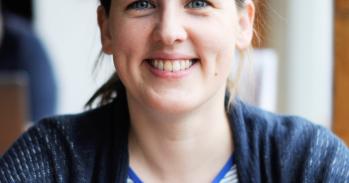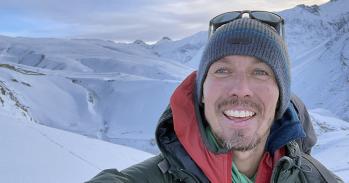
Dr Stephanie Höhn is a postdoctoral researcher in the Department of Applied Mathematics and Theoretical Physics, and a member of Trinity Hall. Here, she tells us about her unusual path to an academic career, the advantages of being a biologist in a mathematics department, and how an organism that can turn itself inside out might one day help us prevent certain birth defects.
Dr Stephanie Höhn is a postdoctoral researcher in the Department of Applied Mathematics and Theoretical Physics, and a member of Trinity Hall. Here, she tells us about her unusual path to an academic career, the advantages of being a biologist in a mathematics department, and how an organism that can turn itself inside out might one day help us prevent certain birth defects.
I work in an interdisciplinary research group including biologists, physicists, mathematicians and engineers. I path to this stage of my career was a little off the beaten track. Before my academic career, I worked as a legal clerk. This provided me with life experience but, seeking more intellectual diversity, I decided at the age of 25 to leave the safety of my job and to study molecular cell biology at Bielefeld University in Germany.
My biology teacher inspired me by going beyond the curriculum and discussing recent discoveries in life sciences with me. I wanted to contribute to increasing our knowledge of the incredible microcosmos of cells and their countless functions in life.
I took a leap of faith at the start of my postdoctoral career. I joined a biophysics group at Cambridge and started engaging with scientific methods that were well outside of my comfort zone at first. The effort required on both sides to communicate across disciplines has been worth it, though. I am now combining mathematical analyses and computational simulations with advanced imaging techniques. This combination enables me to provide missing puzzle pieces to explain how cells manage to self-assemble into functional organs and tissues.
I think it’s important to keep an open mind and consider changes as opportunities. Whichever path you choose to pursue next, you can always change directions, add and combine different fields. Network with people with different backgrounds: discussing things from different angles can be very motivating.
An entirely new world of opportunities opened up to me when I learned how concepts from physics and mathematics can explain the development of living organisms. When observing a growing organism, one naturally wonders how each of the cells ‘knows’ where to go and what to do. It turns out that often very few parameters can lead to very complicated patterns, and it’s interesting looking for equations that explain how these parameters interact.
My work sets out to reveal how cells generate forces that shape developing tissues. When an embryo develops, its cells move and change their shape in an astoundingly coordinated way to form tissues and organs. Errors in this self-organisation can lead to severe birth defects. Many tissues, including our retina, are formed through the folding of cell sheets, like a sheet of paper can be folded into different shapes.
I am using a fascinating and beautiful model organism called Volvox to study how these folding events work. This aquatic micro-organism is almost entirely transparent which allows me to observe the development of its embryos microscopically. Amazingly, its spherical embryos fold in a way that literally turns them inside out. This peculiar process is a normal part of Volvox development and gives me the chance to study the fundamental mechanisms that can cause a cell sheet to fold.
I am using a custom-built microscope to observe this process through time-lapse recordings. I also measure the physical forces in different regions of the cell sheet to reveal which parts are being pulled or pushed into a new shape. I use computer-generated simulations to test my hypotheses on which cells are actively forming the tissue and which ones are just being pushed around by others. Determining the location and mechanical properties of cells that actively shape a tissue might help us in the future to diagnose and find remedies for associated birth defects.
Day-to-day, I could be doing any number of things. My work involves growing model organisms in little water tanks; staring at and recording time-lapse videos of developing organisms with different microscopy techniques and designing optical devices to improve imaging. I also write code for image processing and analysis, process microscopy images and videos with specialised software, and measure shape changes of cells and tissues. I run computer simulations of folding cell sheets and compare them to microscopic observations, measure physical forces in developing tissues, and supervise students.
One of the most exciting days for me was when I managed to visualise the three dimensional shape changes of living Volvox embryos for the first time with our self-built microscope. It was really great to have overcome all the challenges that led up to this. It was then that I realised the potential these under-studied organisms possess to help us understand our own development.
I can be the first person in the world to see so-far unknown microscopic worlds, every time I observe a new species, a new developmental stage or try a different microscopy technique. These are very special moments even before sharing my new findings with the scientific and non-scientific community. A key moment for me was when I started discussing my biological questions with physicists and mathematicians. It was a real eye-opener to see their different perspectives and approaches towards similar questions. It really made me aware of the power of interdisciplinary work.
There are supportive networks for women in STEM in Cambridge. These include, for example; CamAWiSE and the Emmy Noether Society for Women in Mathematics. There are also opportunities for outreach work, such as The Science Festival, the Plant Festival, Open Days and seminars that are open to the public. The University also provides ample opportunities to network with international scientists through local conferences and seminar series in inter-disciplinary fields relevant to my research (e.g. Physics of Living Matter Symposium, the Physics Meets Biology Conference, Building an Organisms Symposium, Evolution and Development seminar series). There are many imaging facilities and networks for imaging facilities (e.g. Cambridge Advanced Imaging Centre, CRUK and EPSRC Cancer Imaging Centre).

The text in this work is licensed under a Creative Commons Attribution 4.0 International License. Images, including our videos, are Copyright ©University of Cambridge and licensors/contributors as identified. All rights reserved. We make our image and video content available in a number of ways – as here, on our main website under its Terms and conditions, and on a range of channels including social media that permit your use and sharing of our content under their respective Terms.




